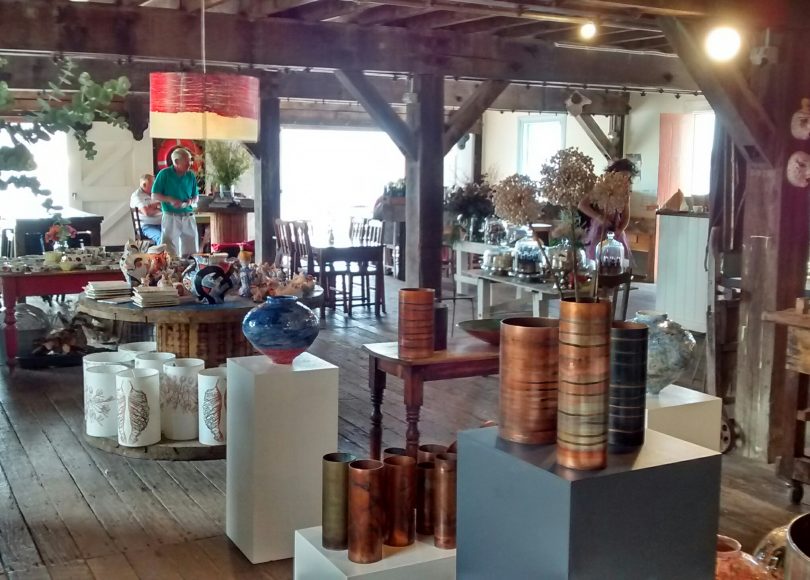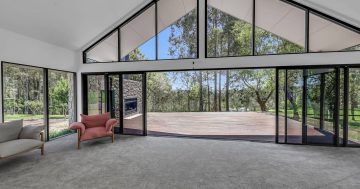
The Melaleuca Safari Tent and fireplace on the shores of Tanja Lagoon. Photos: Supplied, Ian Bushnell.
Calling it glamping would be a disservice to Loz Hunt and Sam Bright, who have transformed an old run-down dairy, flanked by sections of Mimosa Rocks National Park, into re-vegetated wildlife haven by the shores of Tanja Lagoon, just north of Tathra on the NSW South Coast.
With a background in outdoor education, including a stint at Outward Bound in Tharwa during the 1990s, and a passion for the environment and sustainable living, their goal has always been more than just setting up a tourism destination.
They’d had the idea for some sort of accommodation on the property they had inherited but it was a meeting with citizen science advocate, environmentalist and now business partner Libby Hepburn, that galvanised them into action.
“She was passionate about marine ecology and approached us to create something and they would fund it, a citizen science, ‘earthwatch’ kind of holidays vision,” recalls Loz.
“We had it in our minds and then this whole concept came up and we thought, well we could make this happen,” says Sam.

Melaleuca from the inside: functional comfort.
The result is Ecotourism accredited Tanja Lagoon Camp, four luxury self-contained safari tent sites, with fully equipped kitchens and bathrooms attached, facing the lagoon, where you can paddle in the provided canoes or kayaks, walk along round to Middle Beach on a trail through rainforest and spotted gums, or simply watch the sun go down over the water.
We stayed at Melaleuca tent, and with an unreliable internet and mobile phone service, you can disconnect, slow down and engage with the real world around you.
Sam says they had seen the safari tents in Broome where they had been working, but the difference here is the substructure and platform on which they sit that is still a light footprint but provides an off-the-ground security.

Two of the tents have baths for that little extra luxury.
The decking and rafters were made from trees either felled or fallen over on the property and milled on site, while inside the tent there is a beautiful bamboo floor.
The tents are roomy, deliberately so says Sam, who, being a large man, realised the importance of space.
“I think that’s where we’ve made one of our best decisions, to spend a bit more time, effort, and money and end up with a more solid, better construction,” he says.
Inside, there is room for a super comfortable Queen size bed, desk and chair, small settee and coffee table, while on the deck outside is a table and chairs for enjoying a meal looking out to the lagoon.

Swans on Tanja Lagoon. The area is a haven for wildlife.
Loz can take credit for the fit-out and choice of furniture – all tastefully coordinated and functional and importantly blending with the environment.
The overall aim was to have as light a footprint as practically possible, and be sustainable.
With 7kw of solar power available, a worm farm waste system and plenty of water from rainfall and dam, they have the essential services covered. All detergents, soaps, shampoos and conditioners, and toilet paper are eco-friendly, while in the kitchen food such as the supplied bread, muesli, tea, coffee and honey are organic. If you are lucky like us and the hens are laying, there will be fresh eggs. Just let them know about dietary needs.
There are even bathtubs in two of the sites for those in need of a soak after a long day on the water or walking the many bush trails nearby in the national park.

Through the trees on the walk around to Middle Beach.
The only hitch with the waste system was the so-called biodegradable flushable wipes that clogged it up at one point, requiring a clean-out that confirmed just how well the system works with no overwhelming odour or stench. “It was just like mud,” says Loz.
As you’d expect, guests are now asked not to use flushable wipes.
“We have energy, water, and waste covered so we’re getting to a really high level of sustainable living,” says Sam.
For the guests, it means a perfect marriage of comfort and functionality that enables you to have an intimate experience with the environment without roughing it.

The view from the deck.
There is abundant wildlife including kangaroos, wallabies, goannas and any number of bird species for twitchers. It’s a real hit with overseas visitors, which make up more than a third of guests.
Mimosa Rocks National Park offers innumerable walks and beaches, in fact, Sam says there are beaches he hasn’t been to for 10 years because there is always another beach to go to.
Just to the north at the outlet to the sea of the mouth of Lake Wapengo is Bithry Inlet, which is great for calm water swimming, kayaking and exploring the rock formations.
About 10 minutes further north is Aragunnu campground with coastal walks, rocky bays and lookouts, including an Aboriginal midden and the site of the wreck of the steamer Mimosa after which the park is named.
Sam and Loz recommend guests dine in at least one night to enjoy the sunset of Tanja Lagoon, which we did, the gourmet barbecue meeting all our cooking needs. For a campsite experience, gather some wood for a sit around the fire.
But there are also some great dining options in Tathra to the south and north to Bermagui along the coast road.

The Wharf Local is a hub for local food and art.
The Wharf Local on the historic Tathra Wharf is a must for lunch and discovering local artworks, while Fat Tony’s Bar and Grill will surprise for dinner. The refurbished Tathra Hotel has panoramic views and meals.
To the north, Mimosa Winery‘s architect-designed Dry Stone Restaurant has a reputation for fine dining and artisan pizzas.
While there are plenty of outdoor experiences, the area also has a strong arts community, with Tanja full of artist studios. Look out for open studio signs along the road. Just north of Tanja Lagoon Camp is the colonial style farmhouse gallery, Ivy Hill.
In fact, with so much to see and do we suggest taking advantage of Tanja Lagoon Camp’s five-night stay instead of the minimum two-nighter so you don’t have to cram. But first, check the opening times for the area’s attractions as they change with the seasons. Many move from Thursday to Sunday after the summer high season.
On our hosts’ to-do list; include a bigger veg patch for self-picking, bush and forest foods all in a permaculture design, as well as more accommodation, although that is a long-term project.
They have approval for six sites, with plumbing and power ready for the next two, which will be tiny houses rather than tents.
“We can’t open in winter because the tents are too cold so for winter we’d have two tiny houses. Cosy, for those people who are a little sensitive to the shoulder seasons,” they say.
Eventually, they also hope to host citizen science projects where guests can participate in compiling data on the local habitat.
But they are looking at measured growth, mindful of their young family and its needs, and keeping the business manageable.
“Four sites are all we want, we’re going to close for winter, we’re going to keep that model,” Loz says.
For more information see their website http://www.tanjalagooncamp.com.au












